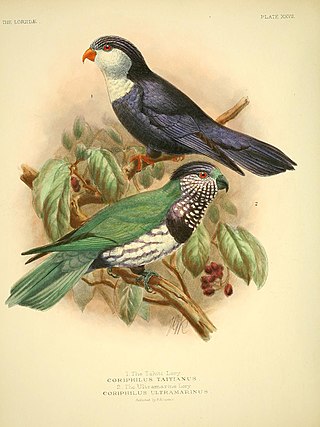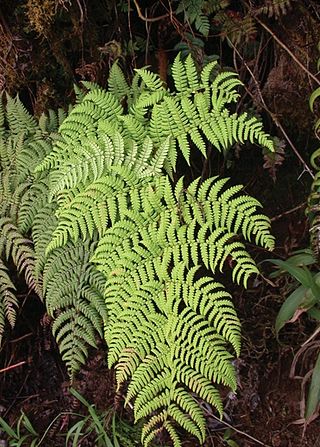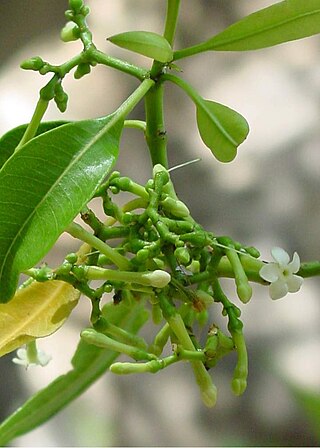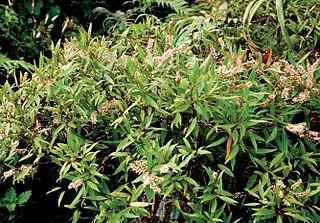
Glochidion is a genus of flowering plants, of the family Phyllanthaceae, known as cheese trees or buttonwood in Australia, and leafflower trees in the scientific literature. It comprises about 300 species, distributed from Madagascar to the Pacific Islands. Glochidion species are used as food plants by the larvae of some Lepidoptera species including Aenetus eximia and Endoclita damor. The Nicobarese people have attested to the medicinal properties found in G. calocarpum, saying that its bark and seed are most effective in curing abdominal disorders associated with amoebiasis.

The ultramarine lorikeet is a species of parrot in the family Psittaculidae, endemic to the Marquesas Islands. Its natural habitats are subtropical or tropical moist lowland forest, subtropical or tropical moist montane forest and plantations. It is threatened mainly by introduction of the black rat and also by deforestation.
Allophylus marquesensis is a species of plant in the family Sapindaceae. It is extant in French Polynesia on the islands of Fatu Hiva, Hiva Oa, Tahuata and Ua Huka.
Glochidion grantii, also known by the synonym Phyllanthus grantii, is a species of tree or shrub in the family Phyllanthaceae. It is endemic to the islands of Tahaa and Raiatea in the Society Islands of French Polynesia, where it is restricted to montane plateaus and ridge forests at elevations of 435–730 meters.
Glochidion longfieldiae, or kaema in the Rapa language, is a species of tree or shrub in the family Phyllanthaceae. It is endemic to the island of Rapa in the Austral Islands in French Polynesia. Molecular phylogenetic analysis indicates that it is extremely closely related to the tree Glochidion rapaense, which is also endemic to Rapa.
Glochidion manono, also known as manono or mahame in Tahitian, is a species of shrub or small tree in the family Phyllanthaceae. It is endemic to the Windward Society Islands in French Polynesia, where it is found on the islands of Tahiti and Moorea. Compared to other species of Glochidion in the Society Islands, G. manono is found in relatively low-elevation areas, including some disturbed environments.
Glochidion moorei is a species of tree in the family Phyllanthaceae. It is endemic to the Te Mehani Plateau on the island of Raiatea in the Society Islands of French Polynesia.
Glochidion myrtifolium is a species of tree or shrub in the family Phyllanthaceae. It is endemic to the Society Islands of French Polynesia, where it is native to the islands of Bora Bora, Tahaa, Raiatea, and Moorea.
Glochidion nadeaudii is a species of tree in the family Phyllanthaceae. It is endemic to the island of Mo'orea in French Polynesia, where it is found on several mountains above 420 meters elevation.
Glochidion papenooense, also known by its synonym Phyllanthus papenooense, is a species of tree in the family Phyllanthaceae. It is endemic to the island of Tahiti in the Society Islands of French Polynesia, where it is restricted to wetland habitats. Because of its rarity, it is protected by law in French Polynesia.
Glochidion raivavense, also known by its synonym Phyllanthus raivavense or by the local name mahame on the island of Tubuai, is a species of plant in the family Phyllanthaceae. It is endemic to the Austral Islands in French Polynesia, where it is native to the islands of Rurutu, Tubuai, and Raivavae.
Glochidion rapaense, also known by its synonym Phyllanthus rapaense, is a species of tree in the family Phyllanthaceae. It is endemic to the island of Rapa in the Austral Islands of French Polynesia. Molecular phylogenetic analysis indicates that it is extremely closely related to Glochidion longfieldiae, which is also endemic to Rapa.
Glochidion taitense, also known by the synonym Phyllanthus taitensis or as mahame in Tahitian, is a species of tree or shrub in the family Phyllanthaceae. It is endemic to the Windward Society Islands of French Polynesia. It is common on the island of Tahiti, where it grows in a wide variety of habitats, but has only been collected once on the nearby island of Moorea, only 17 kilometers distant. It is easily distinguishable from other species of Glochidion on Tahiti and Moorea due to the pubescence on its leaves, young branches, and flowers.
Glochidion temehaniense, also known by the synonym Phyllanthus temehaniensis, is a species of tree in the family Phyllanthaceae. It is endemic to the Society Islands of French Polynesia, where it is native to the islands of Tahaa, Raiatea, and Huahine. Like all other species of Glochidion, it is pollinated by leafflower moths in the genus Epicephala.
Glochidion tooviianum is a species of tree in the family Phyllanthaceae. It is endemic to the Toovii Plateau on the island of Nuku Hiva in the Marquesas Islands of French Polynesia. Wagner and Lorence (2011) consider this species to be the same as Phyllanthus marchionicus, as both species are indistinguishable except for the presence of pubescence on G. tooviianum and the absence of pubescence on P. marchionicus/G. marchionicum.
Melicope nukuhivensis is a species of plant in the family Rutaceae. It is a scrambling shrub or tree endemic to the island of Nuku Hiva in the Marquesas Islands of French Polynesia.
Epicephala spinula is a moth of the family Gracillariidae, one of the most primitive groups of ditrysian "micromoths". Within its family, it belongs to the subfamily Gracillariinae. Even though it was first scientifically studied in 1929, for many decades the specimens of this moth were mistaken for the related Australian species E. colymbetella, and their distinctness was only realized in 1986. It is found on the Marquesas Islands, where it occurs at least on Nuku Hiva, Ua Pou, and Fatu Hiva, and though little-known it is apparently not uncommon. The holotype specimen, a female, is USNM 100839.

Dryopteris macropholis is a species of fern. It is distributed on the Marquesas Islands.

Rauvolfia nukuhivensis is a species of plant in the family Apocynaceae. It is endemic to Nuku Hiva in the Marquesas Islands in French Polynesia.

Pterophylla marquesana, formerly known as Weinmannia marquesana, is a species of plant in the family Cunoniaceae. It is a shrub or tree endemic to the Marquesas Islands of French Polynesia.





